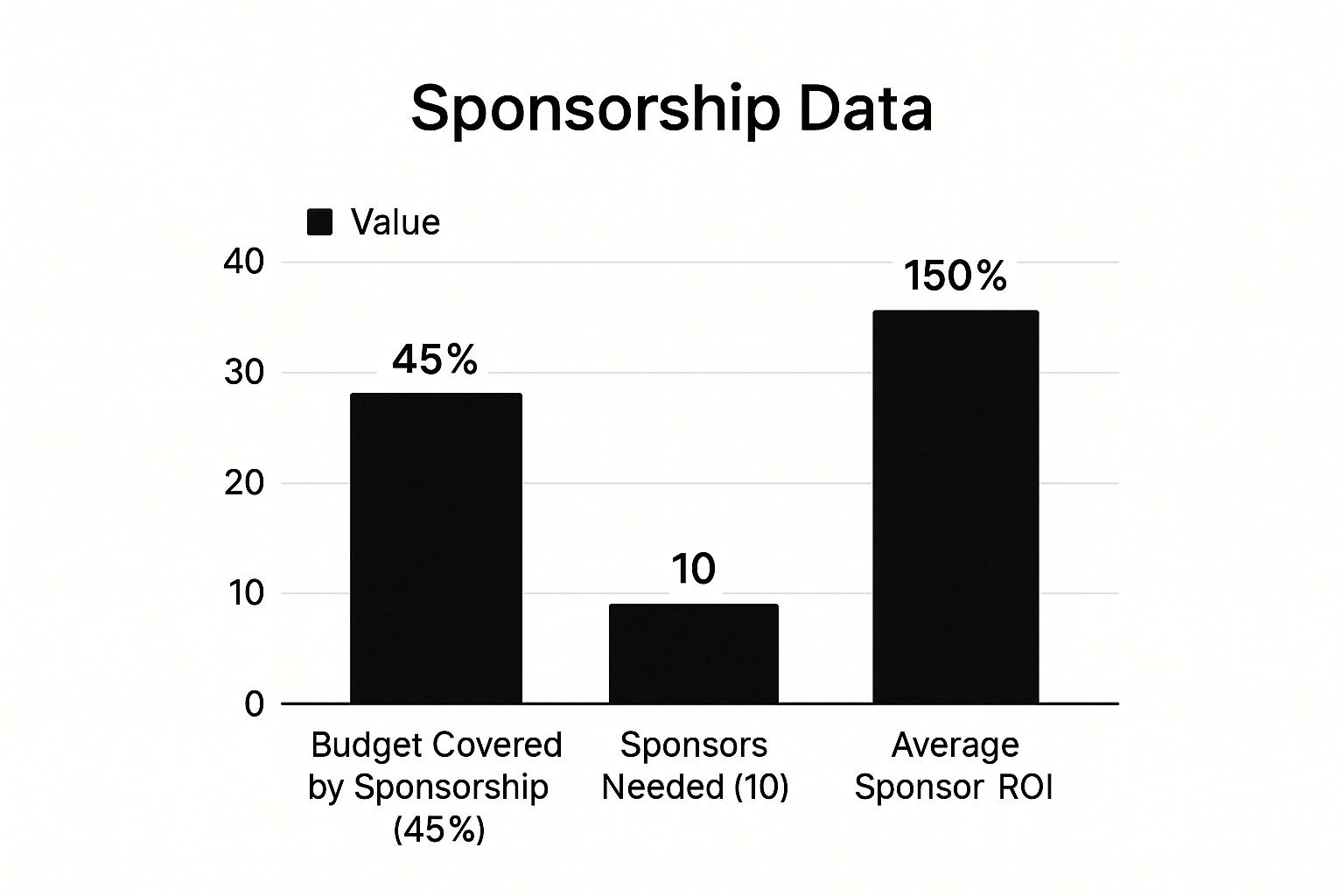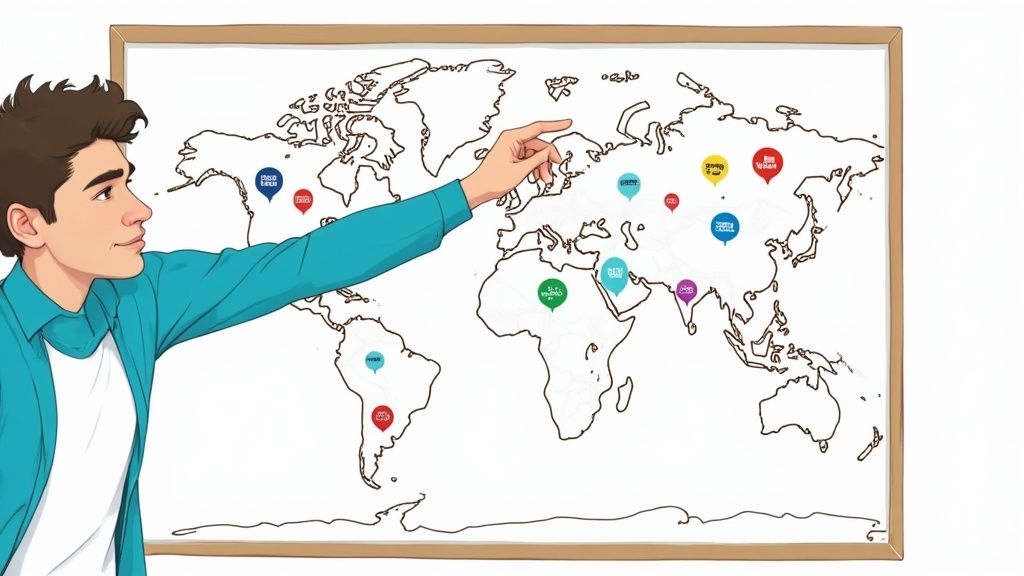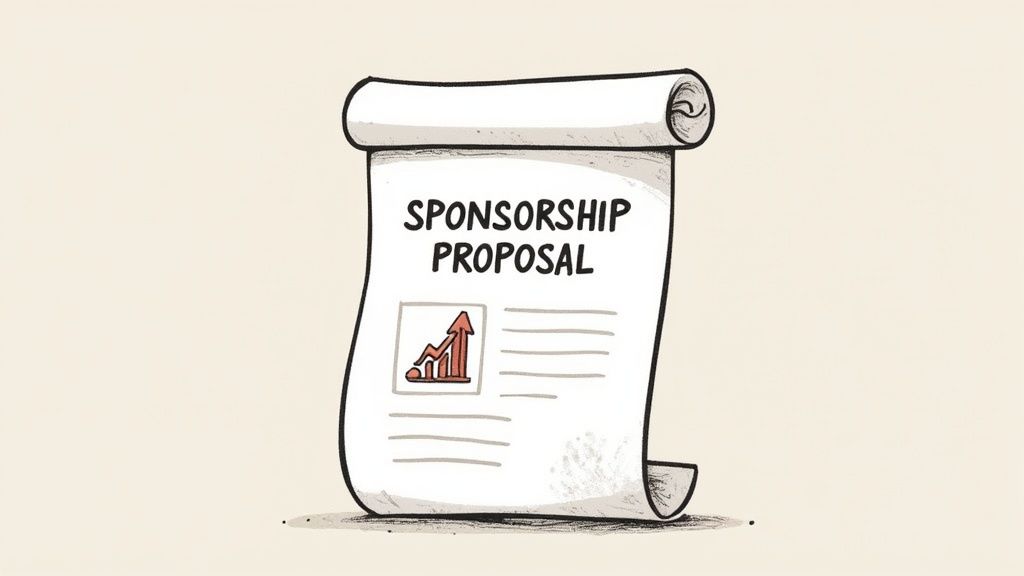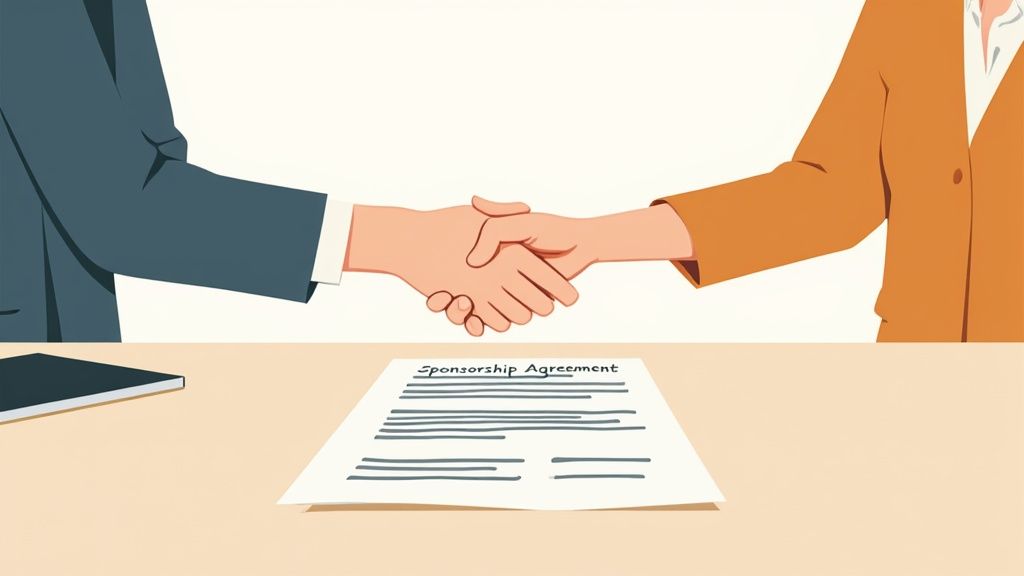How to Find Sponsors for Events with Data
Learn how to find sponsors for events using our proven, data-driven strategies. Discover how to build prospect lists and craft winning proposals.
Finding the right sponsors for your event is less about casting a wide net and more about precision targeting. The real secret? Focus on companies that already have a proven track record of sponsoring events just like yours. As the largest aggregator of conference and sponsor data on the internet, we know this single shift in strategy is what separates the pros from the amateurs, and it dramatically boosts your chances of landing a partnership.
Why Data Is Your New Best Friend in the Sponsorship Game
Let's be honest, the old way of securing event sponsors is dead. Blasting out a generic proposal to a massive email list and just hoping for a nibble doesn't cut it anymore. Today, success is built on a smart, data-driven strategy that turns the frustrating hunt for funding into a focused, almost scientific mission.
As the largest aggregator of conference and sponsor data, we’ve analyzed thousands of events and partnerships. A clear pattern has emerged: the most successful event organizers aren't just selling sponsorship slots—they’re building strategic alliances. They understand that a sponsorship is a two-way street where both the event and the brand need to see a clear return on their investment.
From Sales Pitch to Strategic Partnership
The most important thing you can do is change your mindset. You're not just asking for a check. You're offering a brand a golden ticket to connect with their ideal audience in a meaningful way. This means you have to start thinking like a partner, not a salesperson.
A data-driven approach is what makes this shift possible. It lets you:
- Pinpoint Pre-Qualified Leads: By seeing which companies have sponsored similar conferences in your niche, you immediately have a list of warm leads. These are businesses with proven interest and, more importantly, an allocated budget for exactly this kind of marketing.
- Decode Sponsor Behavior: Data uncovers critical patterns. You can see how much companies typically spend, the types of event activations they prefer, and which industry events they prioritize year after year.
- Build an Irresistible Value Proposition: When you're armed with these insights, you can stop guessing. Your proposal can speak directly to a potential sponsor's marketing goals, showing them you’ve done your homework and truly understand what they need.
The data below paints a clear picture of the financial realities of event sponsorship, underscoring why a targeted approach is so critical for organizers and what kind of ROI sponsors are looking for.

This data reveals a powerful symbiotic relationship. Sponsorships often cover a huge chunk of an event's budget, while sponsors see a significant return on their investment. It's a classic win-win when you find the right fit.
The Shift from Traditional to Data-Driven Sponsorship
To truly grasp the change in strategy, it helps to see the old and new approaches side-by-side. This table breaks down the fundamental shift from volume-based tactics to value-based partnerships.
| Attribute | Traditional Approach | Data-Driven Approach |
|---|---|---|
| Prospecting | Mass email lists, cold calls, "spray and pray." | Analyzing past sponsor data, targeting companies with proven interest. |
| Pitch | Generic, one-size-fits-all proposal focused on event features. | Customized proposal highlighting sponsor's specific ROI and audience alignment. |
| Mindset | Transactional: "Selling a slot." | Relational: "Building a partnership." |
| Measurement | Number of logos on a banner. | Audience engagement, lead quality, brand sentiment. |
| Tools | Basic CRM, email blast software. | Sponsorship databases, intent data platforms, analytics tools. |
The move toward a data-driven model isn't just a trend; it's a strategic necessity for creating valuable, long-term sponsor relationships.
The Bottom-Line Reality of Sponsorships
Sponsorships are no longer just a "nice to have." They are the lifeblood of most events. In fact, a staggering 88.4% of event marketers now count on sponsorships as their main source of revenue.
What’s more, nearly a third of organizers measure their event's success by the quality and number of sponsors they bring on board. This really hammers home just how central they've become to modern event strategy.
The most powerful pitch is one that demonstrates you've done your homework. Using data on past sponsor behavior is the most reliable way to filter out unqualified leads and focus your energy where it counts.
To really get ahead of the curve, you can explore leading intent data providers that offer deep insights into which companies are actively searching for partnership opportunities right now. This guide will walk you through exactly how to use this kind of data to build a pipeline of perfect-fit sponsors.
Pinpointing Your Ideal Sponsor with Data

The biggest resource drain in the sponsorship game isn't crafting the perfect pitch. It's wasting that perfect pitch on the wrong companies. To find sponsors efficiently, you have to stop guessing and start building a hyper-targeted list based on hard data. This means focusing your energy only on companies already active in the conference sponsorship space.
The real goal here is to identify the 'serial sponsors'. These are the companies that consistently fund conferences and trade shows in your specific industry. They've already proven they have the budget, the intent, and a core belief in event marketing as a powerful channel to connect with customers.
Analyzing Historical Sponsorship Data
You need to start thinking of past conferences in your niche not as competition, but as a goldmine of intelligence. By analyzing who sponsored them, you can uncover patterns that will shape your entire outreach strategy. As the largest aggregator of conference data, we see these patterns emerge every single day.
A deep dive into this data gives you far more than just a list of company names. You start to see trends in their investment levels and activation strategies. For instance, does a certain software company always seem to sponsor the networking reception at developer conferences? Does a particular cybersecurity firm consistently go for the top-tier platinum package at security summits?
This is the kind of granular insight that immediately puts you ahead of the curve.
Building Your Pre-Qualified Prospect List
Once you start spotting these patterns, your prospect list is essentially pre-qualified from the get-go. Every company on it is a warm lead because their past behavior signals a strong potential for future investment.
Here’s how you can structure this data-driven approach:
- Identify Similar Conferences: First, list 5-10 conferences from the past two years that share a similar audience or theme to your own.
- Extract Sponsor Lists: Systematically go through each event's website or materials and pull their sponsor lists. Our platform simplifies this by gathering all this information in one place.
- Look for Overlap: Take note of which companies appear on multiple lists. A company that sponsored three of the five conferences you analyzed is a high-priority target.
- Categorize by Investment Level: When possible, jot down the sponsorship tier (e.g., Gold, Platinum, Session Sponsor). This helps you estimate their typical budget and tailor your proposal.
For a real-world example of how this looks in practice, you can explore the sponsorship data for a major event like the Data Masterminds conference to see which brands consistently invest.
By focusing on serial sponsors, you're not just finding companies with a budget; you're finding companies with a pre-existing strategy that your event fits into perfectly. This transforms your pitch from a cold ask into a relevant, timely opportunity.
This methodical process removes the guesswork. Instead of wondering if a company sponsors events, you'll know they do. Your outreach immediately becomes more confident and effective because it’s based on proven behavior, not wishful thinking. You’re now approaching brands that have already bought into the value of what you're offering.
Uncover Your Next Sponsors by Looking at Your Competitors

One of the most effective, yet often overlooked, ways to find sponsors is to look at who is already sponsoring conferences just like yours. Think of your competitors’ sponsor pages as a pre-vetted list of high-potential partners.
The logic here is rock-solid. If a company has sponsored a similar conference, they’ve already bought into your niche. They understand your audience, they see the value, and most importantly, they have a budget allocated for this exact type of marketing. You're not starting from scratch; you're entering a conversation with a company that's already demonstrated interest.
Look Deeper Than Just a List of Logos
Simply copying a list of names isn't the goal. The real work is in understanding the why and the how behind their sponsorship decisions. As the largest aggregator of conference sponsor data, we’ve seen these patterns play out time and time again.
When you dig into a competitor's sponsor page, you’re on an intelligence mission. You’re trying to answer a few key questions:
- Who are the regulars? Pinpoint the companies that appear at multiple related events. These are your prime targets.
- What's their investment level? Do they consistently go for the top-tier platinum packages, or do they prefer smaller, targeted activations like sponsoring the Wi-Fi? This tells you a lot about their budget and strategic goals.
- What message are they sending? Pay attention to their booth and marketing copy. Is it all about brand awareness, or are they focused on generating leads?
For a more structured way to capture this information, you might find value in building a winning B2B competitor analysis framework. It can help you organize your notes and pull out truly actionable insights.
Find High-Potential Prospects with Data
This is where having access to a comprehensive database is a game-changer. Instead of spending hours manually piecing this together, you can see historical data for countless conferences in your industry instantly. With our platform, for example, you can see who the most active sponsors are and which conferences are magnets for funding. You can see this data in action by browsing our list of most-sponsored conferences.
Dissecting your competitors' sponsor lists gives you a powerful head start. You're walking into the conversation already knowing their likely goals, budget, and even their preferred way to engage with an audience.
This data-driven approach is exactly how major industries operate. Take the global sports market. Football sponsorships make up 41% of the entire pie because brands know they are reaching a specific demographic—an audience where 76% are Millennials or Gen Z. This predictability is what makes it such a reliable investment.
Your job is to apply that same level of precision to your own conference. By analyzing past sponsorship behavior, you’re not just building a list of leads; you’re building a pre-qualified pipeline and crafting a pitch that resonates with a prospect’s proven interests. That’s how you dramatically increase your chances of closing the deal.
Crafting Sponsorship Proposals That Get Signed
Once you’ve identified your ideal sponsors, the real work begins. It’s time to build a proposal that feels less like a sales pitch and more like a blueprint for a shared success story. Sending out a generic, one-size-fits-all document is the quickest route to the trash folder. To actually land a sponsor, your proposal has to show you've done your homework and genuinely understand their marketing goals.
The data you've already collected is your secret weapon here. Instead of just rattling off a list of benefits your event offers, you can now frame those opportunities as direct answers to a sponsor’s specific needs. Your job is to connect the dots for them so clearly that the value becomes impossible to ignore.
Tailor Your Pitch with Data-Driven Insights
Let your research guide the entire conversation. Did you notice a potential sponsor consistently buys speaking slots at other industry conferences? That’s your opening. Don't start your email by attaching a generic PDF with a "Gold Tier" package. Lead with the keynote or panel opportunity you have in mind for them.
This immediately proves you’ve done more than scrape their contact info off a website. It shows you understand their playbook. For example, if a company's past sponsorships all point towards a heavy focus on lead generation, your proposal needs to zero in on assets that deliver exactly that:
- Scannable Attendee Badges: Explain how they can capture qualified leads in real-time, right from their booth.
- Access to Attendee Lists: If your privacy policy allows, offer pre- or post-event access to contact information for follow-ups.
- Sponsored Workshops: Propose an intimate, hands-on session where they can demo their product to a captive and highly engaged audience.
This kind of specific, tailored approach is what makes a proposal stand out. It elevates you from just another event looking for a handout to a strategic partner who can deliver measurable business results.
A proposal that gets signed isn't about what your event needs from a sponsor. It's about what your event can do for them. Frame every single benefit in terms of their potential ROI, and use the data you've gathered to make your case.
Structure Sponsorship Tiers for Maximum Appeal
While every conversation should be customized, having structured tiers gives sponsors a clear and immediate understanding of their options. The classic Bronze, Silver, Gold, and Platinum model is popular for a reason—it provides straightforward entry points for different budgets. The trick is to ensure each tier offers a genuinely compelling value proposition.
Think of it as a menu. Someone might just want an appetizer, while another is ready for the full-course meal. Your job is to make every option look delicious.
Here's a sample structure showing how you can balance standard benefits with exclusive opportunities to attract a wide range of sponsors.
Sponsorship Package Tier Comparison
This table outlines a tiered approach designed to cater to different budget levels and marketing goals. Notice how high-value items like speaking slots and exclusive branding are reserved for the upper tiers, creating a natural incentive to invest more for a greater return.
| Benefit | Bronze Tier | Silver Tier | Gold Tier (Most Popular) | Platinum Tier |
|---|---|---|---|---|
| Logo Placement | Website, pre-event email | All Bronze + Event signage | All Silver + On-stage screen | All Gold + Lanyards, app splash screen |
| Exhibit Space | Small tabletop display | Standard 10x10 booth | Premium 10x10 booth location | Premium 10x20 booth, prime location |
| Speaking Slot | None | Panelist opportunity | 20-min breakout session | Keynote or solo main stage slot |
| Comp Tickets | 2 | 4 | 8 | 12 + VIP access |
| Lead Generation | Post-event "thank you" mention | Pre-event email mention | Dedicated email blast | Exclusive sponsorship of networking app |
A well-designed tiered structure makes it easy for a brand to visualize the escalating value. By bundling your most coveted assets—like those main stage speaking slots and exclusive branding on the networking app—into the higher-priced packages, you create a powerful pull for sponsors to commit at a higher level. When they see a clear path to hitting their goals, your proposal is no longer a document to be reviewed; it's a contract waiting to be signed.
Perfecting Your Outreach and Building Partnerships

You can have the most brilliant proposal in the world, but it's worthless if it lands in the wrong inbox—or never gets opened at all. Once you've identified your ideal partners and built a compelling pitch, the real challenge begins: cutting through the noise.
This isn’t about a one-time transaction. It's about starting a genuine, long-term partnership from that very first email.
Your initial outreach is everything; it sets the tone for the entire relationship. The goal is to connect directly with the person holding the keys to the event marketing or sponsorship budget. LinkedIn is invaluable for this, letting you search for titles like "Sponsorship Manager," "Field Marketing Director," or "Head of Partnerships." Sending a personalized connection request, followed by a short, value-packed message, beats a generic email blast every single time.
Crafting Outreach That Actually Gets a Response
Your first email needs to be sharp, respectful, and completely focused on their potential ROI. Anything that smells generic is going straight to the trash folder.
This is where your research pays off. Reference the data you’ve gathered to prove you've done your homework and genuinely understand what they're trying to achieve.
Here's a simple framework that works:
- An Irresistible Subject Line: Ditch the vague stuff. Try something specific and intriguing, like "Partnership Idea for [Sponsor Company] at [Your Event Name]."
- A Human Opening: Show you’re paying attention. Mention a recent company win, a product launch, or a past conference they sponsored that you found in our database.
- The "Why You" Hook: In just one or two sentences, connect the dots. Explain precisely why your event audience is the exact crowd their brand needs to be in front of.
- A Low-Friction Call to Action: Don't just attach your proposal and hope for the best. Ask for a quick 15-minute call to explore how a partnership could directly support their marketing goals for the next quarter.
This approach demonstrates respect for their time and immediately frames the conversation around their needs, not just what you want. If you're looking for more ideas on how to structure your event team for success, our guide to the top event management conferences is a great place to find industry-leading strategies.
From First Contact to Lasting Partnership
Getting that "yes" from a sponsor is just the beginning. The real magic is in delivering an experience so exceptional they can't wait to come back next year. That means clear, consistent communication, proactive support on the ground, and a detailed post-event report that proves their ROI in black and white.
It's also about staying ahead of the curve. The sponsorship world is shifting fast, with a huge move toward digital and hybrid models. In North America, which accounts for about 38.4% of the virtual sports sponsorship market, brands are pulling budget from old-school banners and pouring it into immersive digital placements. Why? Because they're trackable and offer precise ROI measurement, something every marketer craves. You can dive deeper into the rise of virtual sponsorships with these insights from Winmo.
The follow-up is where most deals are won or lost. A single unanswered email doesn't mean "no." A polite, persistent follow-up strategy—offering a new piece of valuable information with each touchpoint—can turn a cold lead into your biggest partner.
Burning Questions About Event Sponsorship
Even with the best data and a solid strategy, you're bound to hit a few common roadblocks. As the biggest aggregator of conference data, we get these questions all the time. Let's tackle the most frequent ones so you can navigate the sponsorship hunt with more confidence.
How Far Out Should I Start Looking for Sponsors?
For any major conference, you need to be thinking about sponsorship 9 to 12 months ahead of time. I can't stress this enough. Big companies often lock in their marketing and event budgets for the next year by Q3 or Q4. If you're not on their radar before those funds are spoken for, you've missed the boat.
For smaller, local, or regional events, you can often get away with a 6-month lead time. The absolute critical takeaway here, regardless of event size, is to have your sponsorship prospectus and data-backed target list finalized before those corporate budgets are set in stone.
What's the Single Biggest Mistake I Can Make When Pitching?
Sending a generic, one-size-fits-all proposal. It's the fastest way to get your email deleted. Sponsors are inundated with these, and they can spot a copy-paste job from a mile away.
Your pitch has to scream, "I did my homework." It needs to show you understand their specific marketing goals and, more importantly, prove exactly how your conference's audience is their target customer.
This is where your data becomes your superpower. A pitch that shows a sponsor how they can get in front of the same audience their competitor paid to reach last year is infinitely more compelling than a generic menu of options. You're offering a strategic advantage, not just another ad space.
How Do I Figure Out What to Charge for Sponsorships?
Pricing feels like a dark art, but it's really a blend of three key elements: the real-world value you provide, your own event costs, and what the market will bear. We see this play out in our data constantly. Start by looking at what similar conferences in your niche are charging. This gives you a credible baseline.
Next, you have to quantify the tangible value you're offering. Think in terms of:
- The number of qualified leads a sponsor can expect, based on your past event data.
- The going rate for a speaking opportunity in your industry.
- The value of brand exposure, calculated by impressions across your website, emails, and social media.
Once you have those numbers, you can build out tiered packages—think Bronze, Silver, Gold—that offer clear, justifiable ROI for sponsors with different budget levels.
Should I Follow Up If I Don't Hear Back?
Yes. A thousand times, yes. Silence almost never means "no." It usually just means your contact is buried in emails and putting out fires. A polite, persistent follow-up is not just acceptable; it's essential.
My rule of thumb is to wait 5 to 7 business days before reaching out again. Don't just send a "just checking in" email. Offer a new piece of information that adds value, like announcing an exciting new keynote speaker or sharing updated attendee registration numbers. Plan on a sequence of 2-3 follow-ups before you put that lead on the back burner. Respectful persistence is what closes deals.
Ready to stop guessing and start using data to find your perfect sponsors? ConferenceDatabase provides the most comprehensive data on past sponsorships, letting you see who is already investing in conferences like yours. Discover high-value sponsorship opportunities and build your pre-qualified list today.